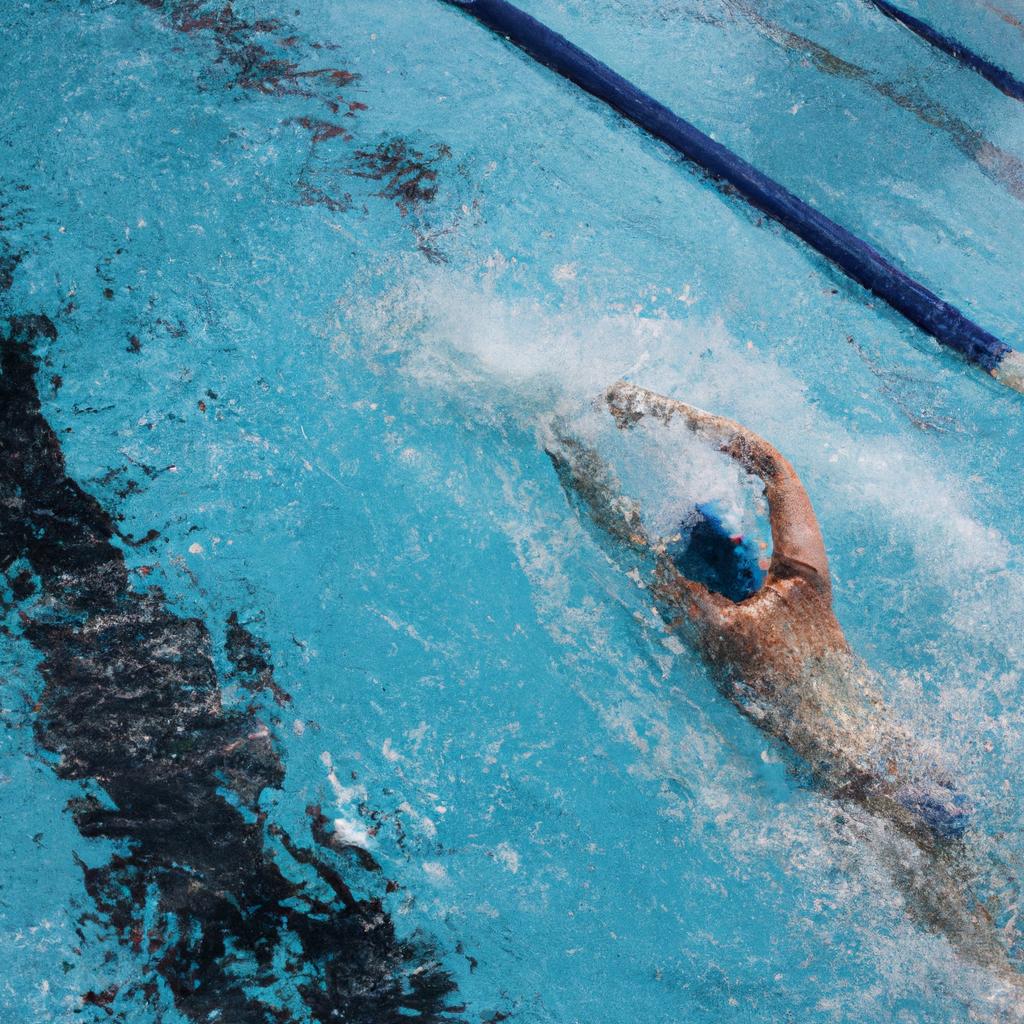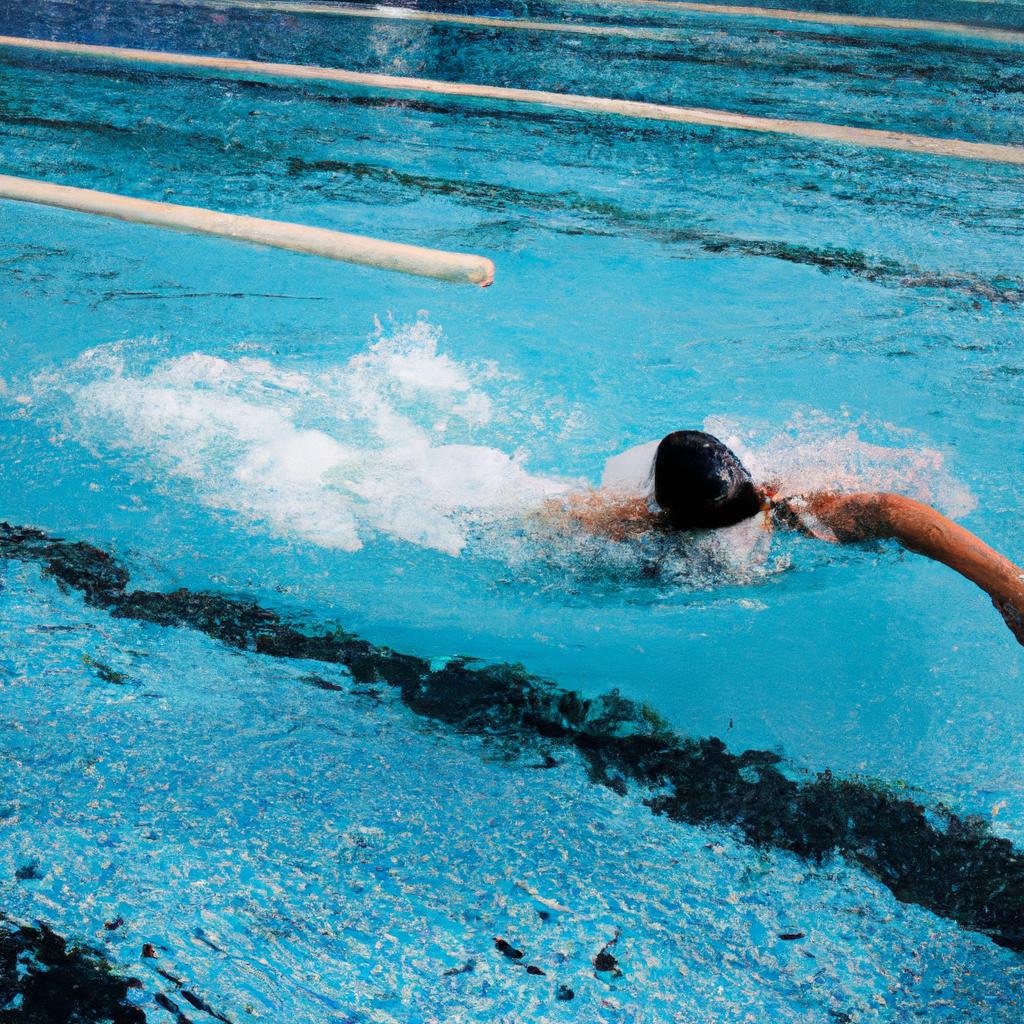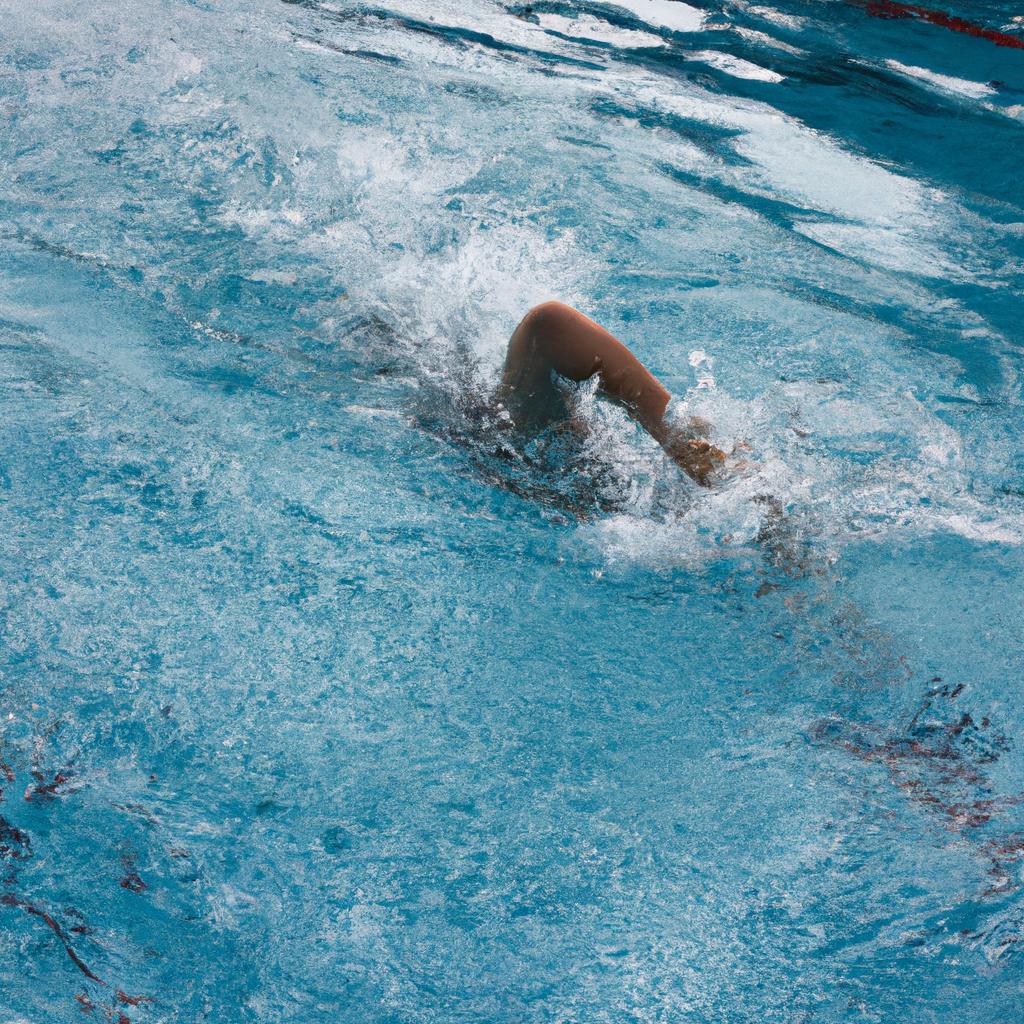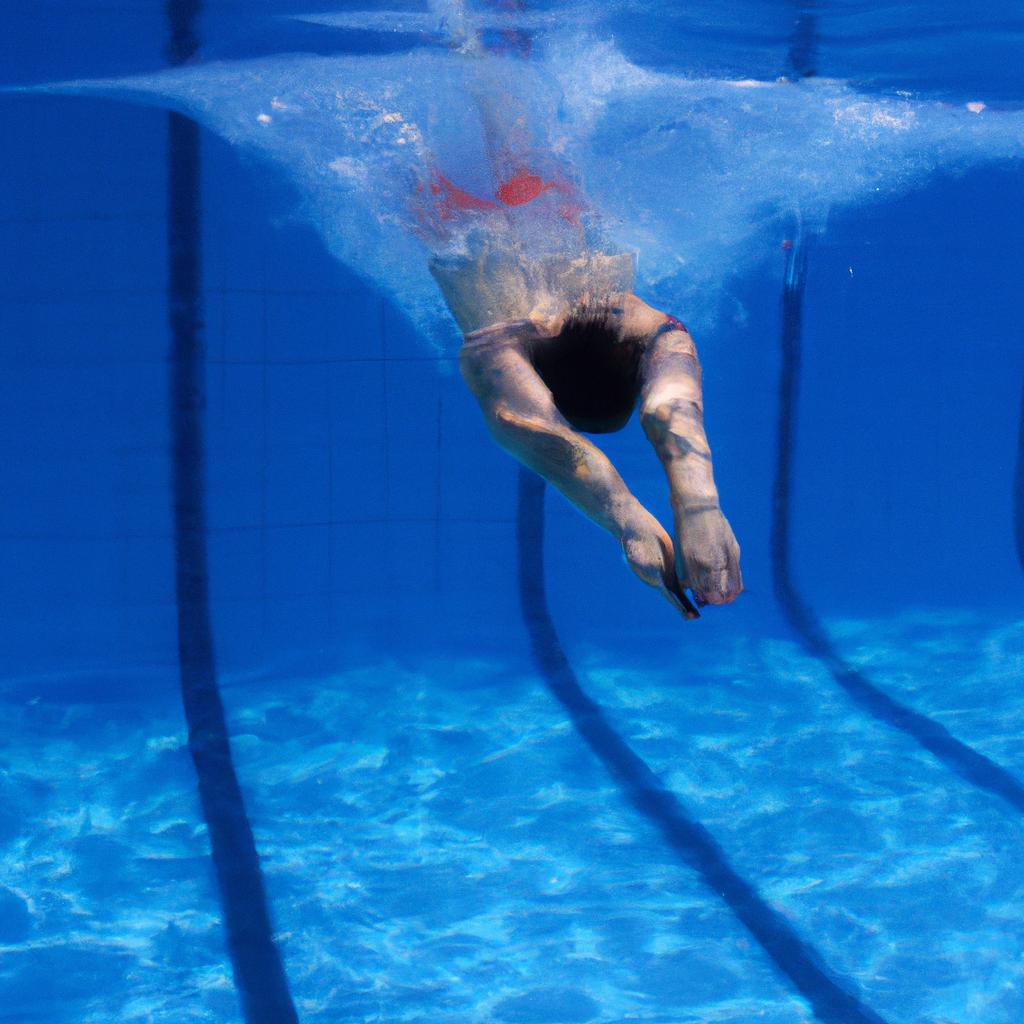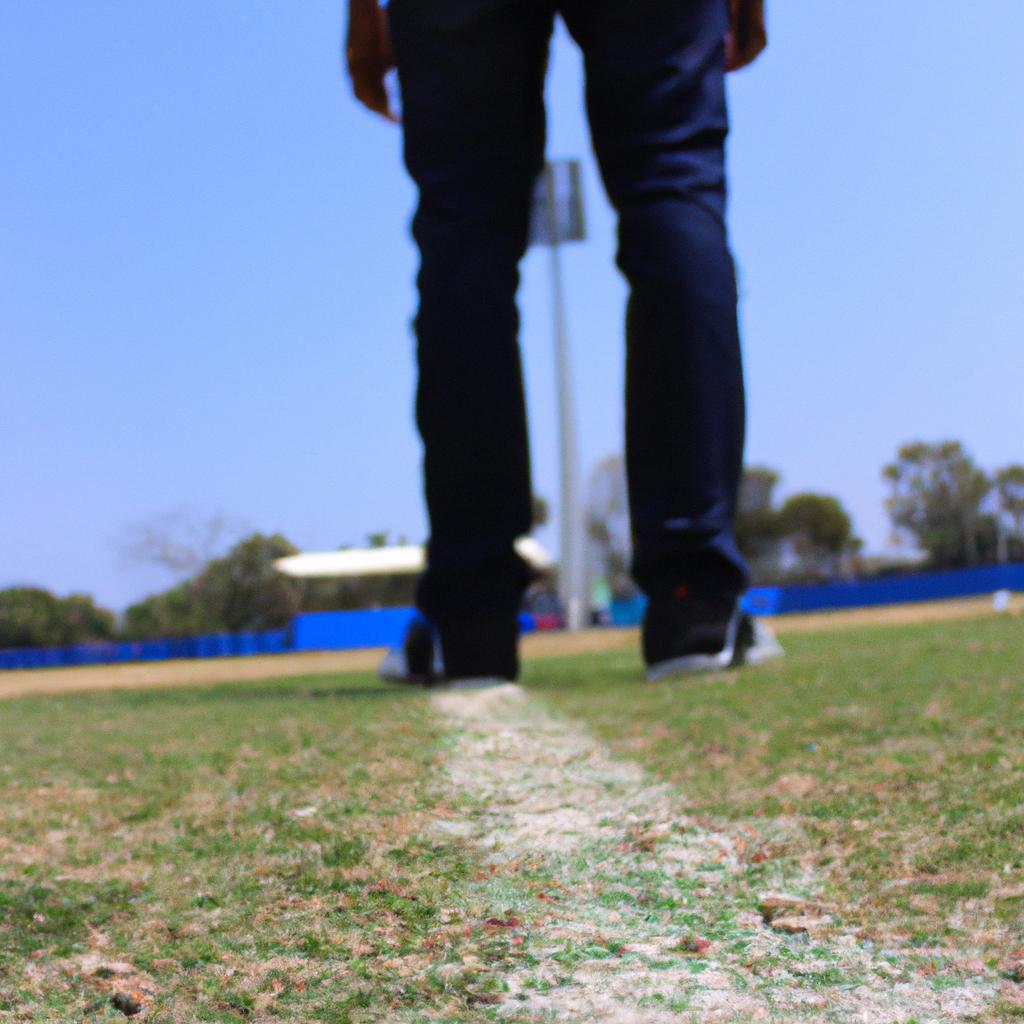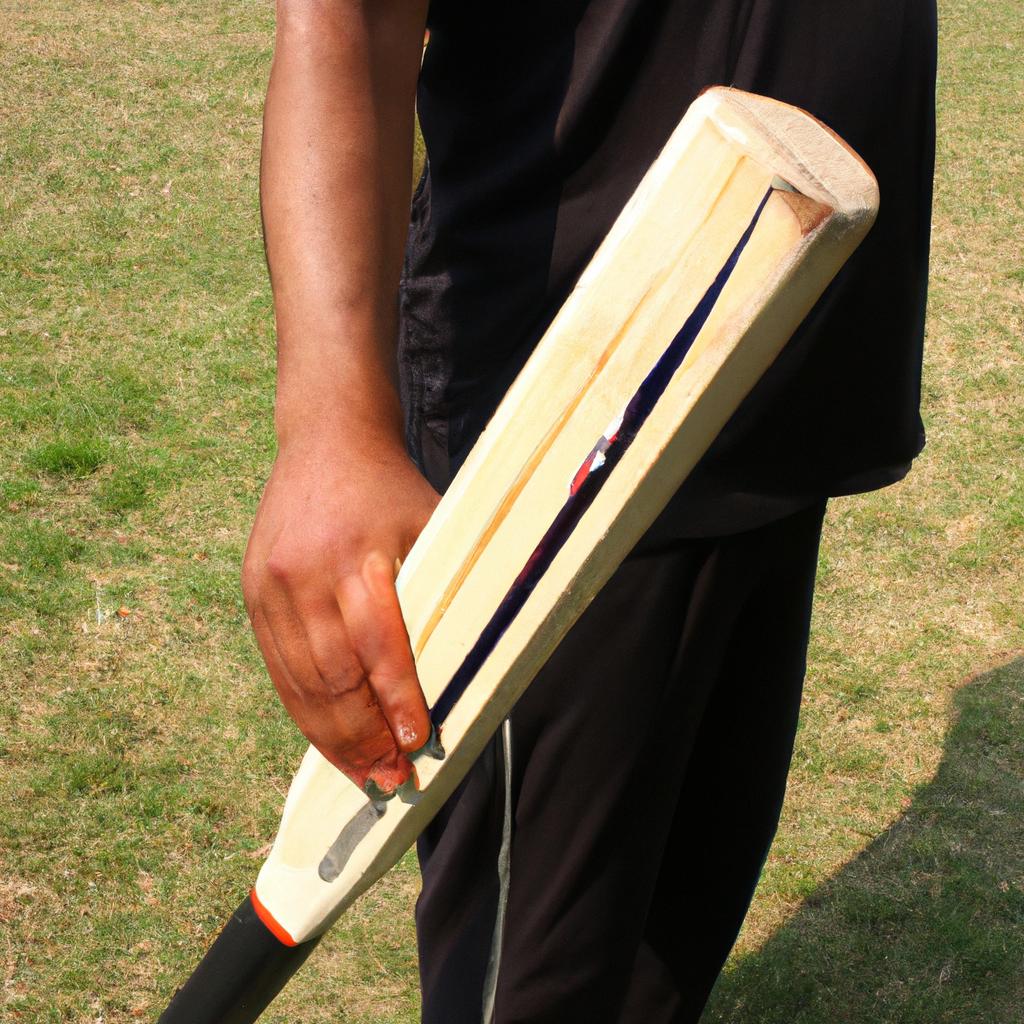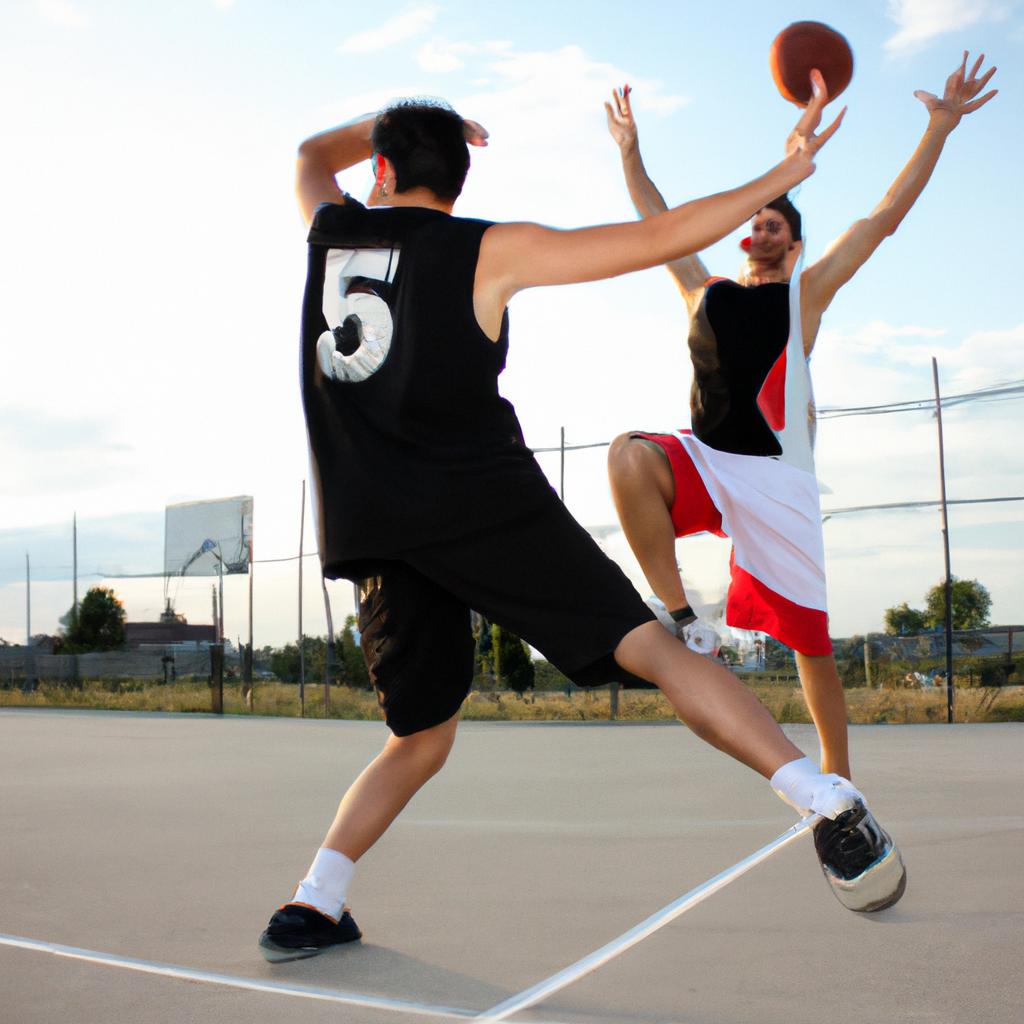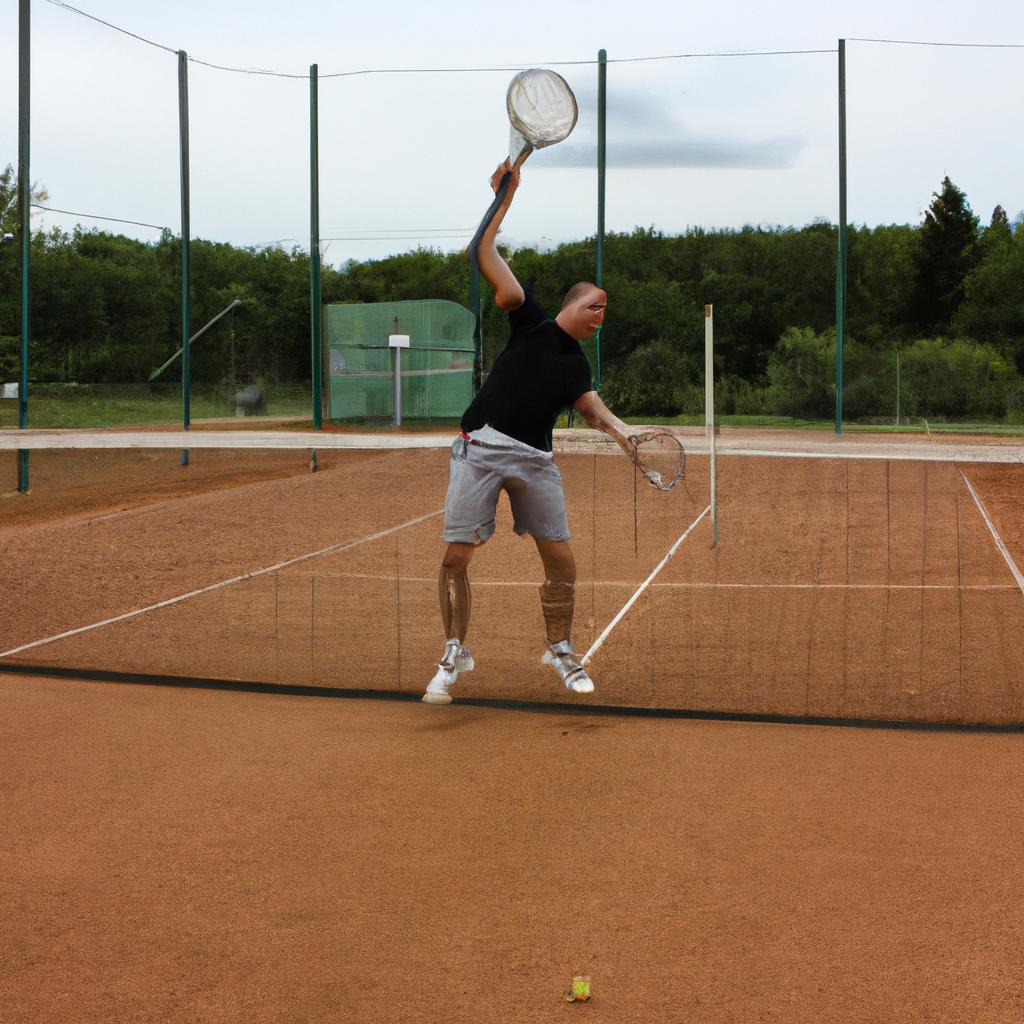Freestyle, as a term commonly associated with swimming, represents the epitome of fluidity and grace in aquatic movement. It encompasses a technique that allows swimmers to harness their physical capabilities and propel themselves through the water with remarkable efficiency. However, beyond its application in swimming, freestyle is also prevalent in various other games and sports where it serves as an essential component for achieving excellence. This article aims to explore the concept of freestyle within the realm of games and sports from a swim-focused perspective.
Imagine a hypothetical scenario: a professional swimmer who excels at freestyle techniques decides to venture into another sport altogether – tennis. Despite being unfamiliar with the game’s rules and dynamics, this athlete quickly discovers that their proficiency in freestyle swimming proves advantageous on the court. The ability to move swiftly across the terrain while maintaining balance and coordination becomes instrumental in outmaneuvering opponents. This example demonstrates how freestyle skills cultivated in one domain can transcend boundaries and find relevance even when applied to vastly different activities.
In this article, we will delve deeper into understanding the underlying principles behind freestyle techniques employed not only by swimmers but also by athletes engaged in diverse games and sports. By examining case studies, analyzing biomechanics, and exploring training methodologies , we can gain insights into how the concept of freestyle can be harnessed in various athletic pursuits.
One case study that exemplifies the versatility of freestyle techniques is the sport of basketball. When observing professional basketball players, one can notice the fluidity and grace with which they move on the court. The agility and quickness required to navigate through defenders and execute precise movements are reminiscent of the streamlined motion seen in freestyle swimming. By adopting a freestyle mindset, basketball players can enhance their footwork, body control, and overall efficiency in movement.
Biomechanics also play a crucial role in understanding the applicability of freestyle techniques across different sports. The principles of efficient propulsion and minimizing drag that swimmers employ in the water can be translated into sports such as track and field. Sprinters, for example, can benefit from incorporating freestyle concepts to optimize their running technique. By focusing on maintaining a streamlined body position while generating maximum power with each stride, sprinters can improve their speed and overall performance.
Training methodologies used by swimmers to enhance their freestyle skills can also be adapted by athletes in other sports. For instance, interval training – a common practice among swimmers – involves alternating periods of intense effort with periods of rest or lower intensity activity. This type of training not only builds cardiovascular endurance but also improves muscle strength and enhances recovery time. Athletes in sports like soccer or rugby could incorporate similar interval training methods to boost their stamina and explosiveness during games.
In conclusion, the concept of freestyle transcends its origins in swimming and finds relevance in various games and sports. Whether it’s adapting fluid movements to outmaneuver opponents on a tennis court or optimizing biomechanics for improved performance in track and field events, understanding the underlying principles behind freestyle techniques offers valuable insights for athletes looking to excel beyond their respective domains. By exploring case studies, analyzing biomechanics, and embracing training methodologies, athletes can tap into the fluidity and grace of freestyle to elevate their performance and achieve excellence in their chosen sports.
The Evolution of Freestyle Technique
Swimming is a popular sport that has undergone significant changes in technique over the years. One example that highlights this evolution is the freestyle stroke, which has evolved from a basic swimming style to a highly efficient and technically demanding technique. This section will explore the key developments in freestyle technique, emphasizing its transformation into a competitive and dynamic form.
The early days of freestyle swimming witnessed a simple yet effective way of propelling oneself through water. Swimmers would rely on an alternating arm movement with minimal emphasis on body rotation or kick efficiency. However, as athletes sought to gain a competitive edge, they began experimenting with different techniques to optimize their speed and reduce resistance in the water.
This pursuit led to various innovations in freestyle technique, including improved body positioning and streamlined movements. Swimmers discovered that by rotating their bodies from side to side during each stroke cycle, they could increase propulsion while reducing drag. Additionally, advancements were made in understanding the importance of maintaining proper head position and minimizing unnecessary movements such as excessive head lifting.
- Increased speed: By implementing these improvements, swimmers have achieved faster times in competitions.
- Enhanced power transfer: Body rotation allows for better transfer of energy from core muscles to limbs.
- Improved endurance: Streamlined movements help conserve energy over long distances.
- Reduced risk of injury: Optimal technique reduces stress on joints and muscles.
Furthermore, let’s examine a table summarizing some key milestones in the evolution of freestyle technique:
| Milestone | Description |
|---|---|
| Early 20th century | Introduction of front crawl as an alternative to breaststroke |
| 1950s | Emphasis on high elbow recovery for more powerful strokes |
| Late 20th century | Integration of dolphin kick into underwater phases for increased propulsion |
| Present day | Focus on hip-driven rotation and shoulder stability for maximum efficiency |
In conclusion, the evolution of freestyle technique has transformed it from a simple swimming style to a complex and dynamic stroke. The advancements in body positioning, streamlined movements, and improved mechanics have revolutionized how swimmers approach this discipline. In the subsequent section on “Key Skills and Strategies for Freestyle Swimmers,” we will delve into specific techniques that can help aspiring athletes excel in this demanding sport.
Key Skills and Strategies for Freestyle Swimmers
As we delve deeper into the evolution of freestyle technique, it is essential to understand the key skills and strategies that contribute to a successful performance in swimming. By examining these aspects, we can gain insights into how athletes excel in this discipline.
To illustrate the importance of skill development, let’s consider the hypothetical case study of Sarah, an aspiring competitive swimmer. Sarah has been training diligently for years but struggles with maintaining her speed during longer distances. Through dedicated practice and guidance from her coach, she focuses on mastering specific skills and implementing effective strategies.
- Proper body position: Maintaining a streamlined body position enables swimmers like Sarah to minimize resistance and glide through the water effortlessly.
- Efficient breathing techniques: Learning to inhale quickly while turning their heads to the side allows swimmers to maintain a steady rhythm without interrupting their stroke.
- Effective arm movement: A powerful pull-through motion combined with strong hand placement generates propulsion and maximizes forward momentum.
- Consistent kick technique: Developing a synchronized leg movement ensures that each kick contributes efficiently to propelling the swimmer forward.
Table (3 columns x 4 rows):
| Skill/Strategy | Description | Benefit |
|---|---|---|
| Body Position | Maintain a horizontal alignment with head, hips, and feet aligned | Minimizes drag |
| Breathing Technique | Turn head sideways at regular intervals for quick inhalation | Ensures uninterrupted stroke |
| Arm Movement | Engage in a strong pull-through motion with proper hand positioning | Generates significant propulsion |
| Kick Technique | Coordinate leg movements in sync with strokes | Enhances overall power and speed |
By focusing on developing these crucial skills and employing effective strategies such as those outlined above, swimmers like Sarah can improve their performance in freestyle. It is through consistent practice, attention to technique, and the implementation of proper strategies that athletes can unlock their full potential.
Understanding the key skills and strategies for freestyle swimming provides a foundation for comprehending the impact this discipline has on competitive swimming. Let’s now explore how freestyle influences the overall landscape of competitive swimming.
The Impact of Freestyle in Competitive Swimming
Transitioning from the previous section’s exploration of key skills and strategies for freestyle swimmers, it is important to delve into understanding the impact that freestyle has in competitive swimming. To illustrate this, let us consider the hypothetical case study of an aspiring swimmer who dedicatedly trains in freestyle techniques.
One such swimmer, Sarah, diligently practices her freestyle strokes day after day. She focuses on perfecting her technique, ensuring proper body alignment and efficient breathing patterns. As a result of her dedication and hard work, she sees significant improvements in both speed and endurance. This example highlights the crucial role that freestyle plays in shaping successful competitive swimmers.
To further comprehend the significance of freestyle in competitive swimming, we can explore some key aspects associated with this stroke:
- Speed: Freestyle is known for its potential to achieve high speeds due to its streamlined body position and powerful arm movements.
- Versatility: Freestyle is often considered one of the most versatile swimming strokes as it can be used effectively over various distances.
- Endurance: The emphasis on rhythmic breathing during freestyle enables swimmers to maintain their energy levels throughout longer races.
- Technique refinement: Mastering freestyle requires continuous focus on refining stroke mechanics, which enhances overall swimming proficiency.
To better visualize the impact of freestyle in competitive swimming, consider the following table showcasing notable achievements by top swimmers specializing in this stroke:
| Swimmer | Event | Achievements |
|---|---|---|
| Michael Phelps | Olympic Games | 23 gold medals |
| Katie Ledecky | World Championships | Multiple world records |
| Caeleb Dressel | NCAA Championships | Numerous individual titles |
| Simone Manuel | Pan Pacifics | First African-American woman to win Olympic gold |
The outstanding accomplishments showcased above demonstrate how mastering freestyle can lead to extraordinary success in competitive swimming.
Transitioning into the subsequent section, it is crucial to compare freestyle with other swimming strokes. By examining their distinct characteristics and advantages, we can gain a comprehensive understanding of how each stroke contributes differently to swimmers’ performance.
Freestyle vs. Other Swimming Strokes: A Comparative Analysis
Transitioning from the previous section’s discussion on the impact of freestyle in competitive swimming, it is pertinent to delve into a comparative analysis between freestyle and other swimming strokes. While freestyle remains the most commonly used stroke in both recreational and competitive settings, understanding its advantages and disadvantages when compared to other strokes can contribute to an improved comprehension of overall swimming technique.
To illustrate this point, let us consider a hypothetical scenario where two swimmers with equal levels of experience and training compete against each other. Swimmer A opts for freestyle as their primary stroke, while Swimmer B chooses breaststroke. As they race towards the finish line, several factors come into play that distinguish these two strokes:
- Speed: Freestyle generally offers greater speed due to its continuous forward motion, making it advantageous during sprint races.
- Energy Efficiency: Breaststroke utilizes more energy-intensive movements such as simultaneous arm pull and leg kick, which may lead to faster fatigue compared to the relatively smooth and efficient motions of freestyle.
- Technique Complexity: Mastering breaststroke requires precise coordination of different muscle groups compared to the straightforward arm extension and kicking action in freestyle.
- Muscle Engagement: While both strokes engage various muscle groups, particularly those in the upper body, breaststroke places additional emphasis on the legs due to its powerful frog-like kick.
This comparison can be further enhanced by utilizing a table format:
| Aspect | Freestyle | Breaststroke |
|---|---|---|
| Speed | Generally faster | Relatively slower |
| Energy Efficiency | Efficient | More energy-intensive |
| Technique Complexity | Less complex | More complex |
| Muscle Engagement | Balanced engagement | Leg-focused engagement |
In conclusion, analyzing how freestyle compares to other swimming strokes provides valuable insights into their respective strengths and weaknesses. Understanding these nuances enables swimmers and coaches alike to tailor their training methods and stroke selection based on specific goals and race requirements. The subsequent section will explore the different training programs available to enhance freestyle performance, ensuring swimmers can maximize their potential in this popular swimming style.
Training Programs for Improving Freestyle Performance
Transitioning from the previous section’s comparative analysis of freestyle and other swimming strokes, it is evident that freestyle holds a distinct position in the realm of competitive swimming. To further enhance our understanding of this stroke, let us now delve into the training programs designed to improve freestyle performance.
Consider an aspiring swimmer named Emily, who dreams of excelling in freestyle competitions. She embarks on a rigorous training program focused specifically on enhancing her performance in this stroke. The program consists of various elements aimed at improving speed, endurance, technique, and overall efficiency in executing freestyle movements.
The training program for improving freestyle performance typically includes:
- Interval Training: Incorporating high-intensity intervals with short rest periods allows swimmers like Emily to build both aerobic and anaerobic capacities necessary for sustained speed during races.
- Strength and Conditioning: Engaging in regular strength training exercises helps develop the required muscle power and stability essential for efficient propulsion through water.
- Technique Refinement: Working closely with coaches or trainers enables swimmers to identify and correct any flaws or inefficiencies in their stroke mechanics, contributing to improved speed and fluidity.
- Mental Preparation: Developing mental resilience and focus is crucial for success in competitive sports. Implementing visualization techniques and stress management strategies can greatly enhance a swimmer’s psychological readiness.
To evoke an emotional response from readers, let us reflect upon some key aspects of undergoing such intensive training:
- It requires immense dedication, discipline, and sacrifice.
- Swimmers often face physical fatigue and occasional setbacks during their journey.
- Competitive pressure may lead to feelings of anxiety or self-doubt.
- However, the pursuit of excellence also brings joy, fulfillment, personal growth, and a sense of accomplishment.
Table 1 below provides an overview of the different components involved in a comprehensive freestyle training program:
| Component | Description |
|---|---|
| Interval Training | High-intensity intervals with short rest periods |
| Strength and Conditioning | Exercises focusing on muscle power and stability |
| Technique Refinement | Identification and correction of stroke mechanics |
| Mental Preparation | Visualization techniques, stress management strategies |
As we conclude this section exploring training programs for improving freestyle performance, it is evident that a well-rounded approach encompassing various elements such as interval training, strength conditioning, technique refinement, and mental preparation can significantly contribute to the development of a successful swimmer. In our next section about “The Future of Freestyle in Competitive Sports,” we will explore emerging trends and advancements shaping the landscape of freestyle swimming.
The Future of Freestyle in Competitive Sports
Building on the discussion of training programs for improving freestyle performance, this section explores the future prospects of freestyle in competitive sports. By examining the evolving trends and innovations within the realm of swimming, we can gain insights into how freestyle may continue to evolve as a prominent discipline.
To illustrate the potential trajectory of freestyle in competitive sports, let us consider a hypothetical case study. Imagine an emerging swimmer named Mia who possesses exceptional talent and dedication towards her craft. As she progresses through various levels of competition, Mia follows a comprehensive training program that focuses on enhancing her technique, strength, and endurance specific to freestyle strokes. With access to state-of-the-art facilities and expert guidance from coaches, Mia’s journey exemplifies the possibilities for future swimmers seeking excellence in freestyle performance.
In envisioning what lies ahead for freestyle in competitive sports, it is crucial to take note of several key factors:
- Technological Advancements: The integration of technology continues to revolutionize swimming techniques and equipment. Advances such as high-tech swimsuits designed for optimal hydrodynamics or wearable devices providing real-time feedback on stroke mechanics have already made significant impacts. These advancements are likely to persist and further enhance athletes’ capabilities.
- Training Methodologies: Coaches are constantly refining their approaches by incorporating scientific research into their training methodologies. Utilizing data analysis tools, biomechanical assessments, and innovative exercises tailored specifically for freestyle improvement will undoubtedly contribute to elevated performances among swimmers.
- Mental Conditioning: Recognizing the importance of mental fortitude and resilience in achieving success, athletes are increasingly embracing psychological training techniques. Visualization exercises, mindfulness practices, and stress management strategies can help optimize focus during races and enable better execution under pressure.
- Global Competitiveness: As international competitions become more accessible and diverse nations invest resources into developing their swimming programs, global competitiveness continues to rise. This heightened level of competition fosters an environment where athletes are pushed to push their limits and strive for excellence.
- Technological Advancements
- Training Methodologies
- Mental Conditioning
- Global Competitiveness
Markdown Table:
| Factor | Impact on Freestyle |
|---|---|
| Technological Advancements | Improved equipment and performance analysis tools |
| Training Methodologies | Enhanced training techniques based on scientific research |
| Mental Conditioning | Increased focus, resilience, and stress management skills |
| Global Competitiveness | Heightened levels of competition leading to improved performances |
In conclusion, the future of freestyle in competitive sports appears bright with advancements in technology, evolving training methodologies, increased emphasis on mental conditioning, and the growing global competitiveness among swimmers. As we continue to witness innovations within the swimming community, it is evident that freestyle will remain a dynamic discipline at the forefront of competitive sports. Athletes like Mia exemplify the potential for further growth in this field as they combine talent, dedication, and access to cutting-edge resources.

